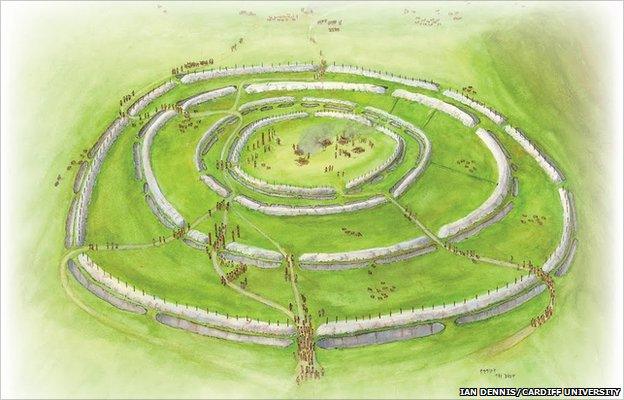Archaeologists unearth Britain's 'first building boom'
- Published

The Trundle near Chichester, Sussex, is one of the first large monuments built in Britain
Researchers have developed a new dating technique that has given the first detailed picture of the emergence of an agricultural way of life in Britain more than 5,000 years ago.
A new analysis of artefacts recovered from the first monuments built in Britain shows that the Neolithic period had a slow start followed by a rapid growth in trade and technology.
Scientists say the new approach can be used to unravel the detailed sequence of events of many more important moments in human prehistory.
It relies in part on radio-carbon dating - counting the amount of a radioactive type of carbon atom in decaying matter. But the methodology also incorporates many other dating sources, together with some powerful statistical analysis, to produce far more discrete timings for happenings in the past.
The Neolithic period in Britain occurred between 4000 and 2000BC.
It was when people took up agriculture as a way of life and stopped being nomadic hunter-gatherers.
It also saw the emergence of trade across the British Isles and the development of new technologies. But until now, we have had only a rather coarse picture of the chronology of events during this eventful period in our history.
The new analysis by Dr Alex Bayliss, an English Heritage dating expert, has brought the occurrences of that time into sharper focus.
"We can start to tell a bigger story and write a history for the prehistory of Neolithic Britain," she told BBC News.
"What we thought before was very imprecise. We simply knew that all sorts of different sites and all sorts of new kinds of practices started to happen sometime in the 500 or 600 years of the early Neolithic in Britain.
"We've actually now been able to give a timetable, or story of what happened when, to disentangle these things so that we can start to see why certain things may have followed others."
According to Dr Bayliss's analysis, Neolithic farming practices began in south-east England probably a few decades before 4,000BC. But then they spread very, very slowly, taking about two centuries to reach western parts of England. And then, she says, there was a sudden increase in activity.
"Monuments, cattle, sheep, the whole farming way of life, bursts across Britain and suddenly - having taken 200 years from getting from Kent to Gloucestershire - it then takes 50 years to get from Cheltenham to Aberdeen."
The new dating also indicates that by 3700-3800BC, early Britons had developed pottery with regional styles of decorations. Long-distance trading networks were also being established in stone axes and certain other types of pottery.

Windmill Hill, a large Neolithic causewayed enclosure in Avebury, was previously thought to have been built around 3700-3100 BC. The new dating shows it was built in 3700-3640 BC
Of particular interest are the first monuments that were built in Britain, called causewayed enclosures. These were made up of concentric rings of ditches and banks - the largest of which can span 300m (1,000ft).
It had been thought that they spread slowly across the country over five centuries. But the new dating approach suggests they spread rapidly within 75 years.
This revelation has been described by archaeologists working on the project as Britain's first "building boom".
Professor Alistair Whittle of Cardiff University said: "With more accurate dating, the Neolithic period is no longer the sleepy, hazy swathe of time where it is the default position to lump everything together.
"This research fundamentally challenges the notion that little happened among our Stone Age farmers. We can now think about the Neolithic period in terms of more rapid changes, constant movement of people and fast diffusion of ideas."
Collective violence
One interpretation of these events is that once the initial "pioneer" phase of the Neolithic period was over, independent groups of people came over from the continent and set up villages across Britain and social structures began to form.
These social structures led to the construction of the enclosures for people to gather and possibly for chieftains to emerge and amass power.
The new dating suggests that there was more collective violence once the enclosures were built. Several of them, particularly in western Britain, were attacked by large numbers of people with showers of arrows, and enclosures' ramparts were burned down.
This indicates that the enclosures created a hierarchy that was being contested in some way.
The new dating technique involves comparing carbon dates with other markers in the archaeological record. On its own carbon dating is imprecise, but when it is cross-reference with documented events it allows researchers to more accurately date artefacts.
Researchers say this new methodology could in principle be used shed further light on any significant event in our prehistory, such as the emergence of farming in China and the collapse of the Mayan civilisation in the Americas.

A reconstruction of the Whitehawk causewayed enclosure in the South Downs, Sussex
- Published26 November 2010
- Published7 June 2010